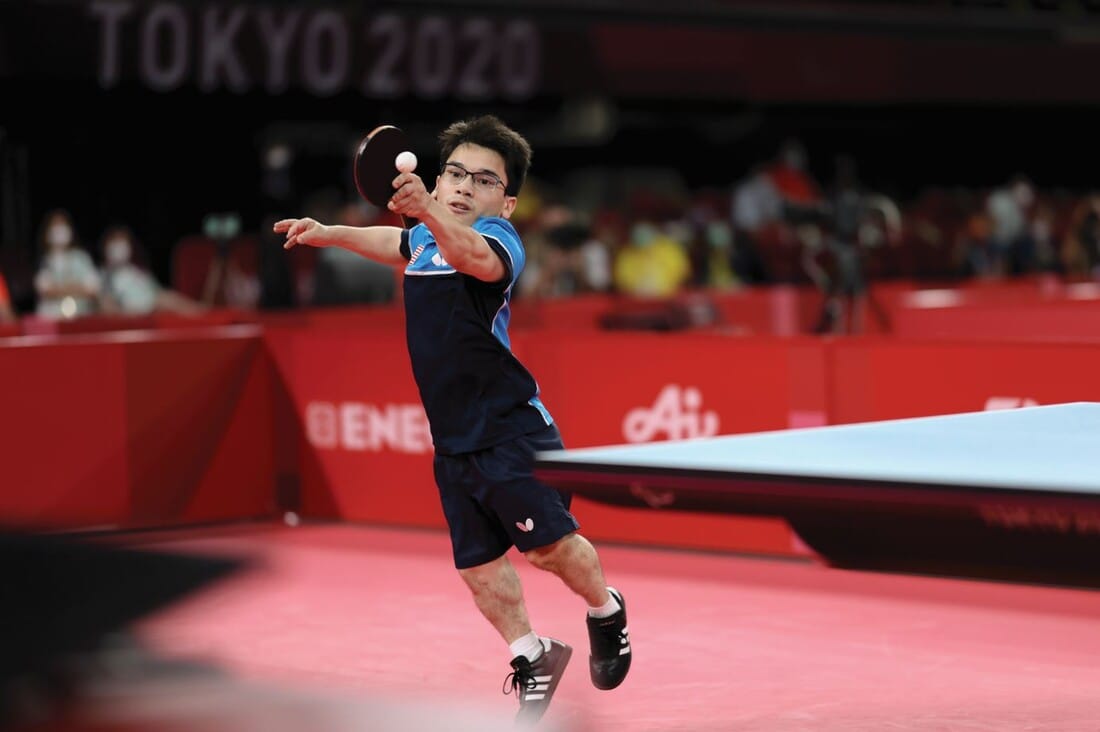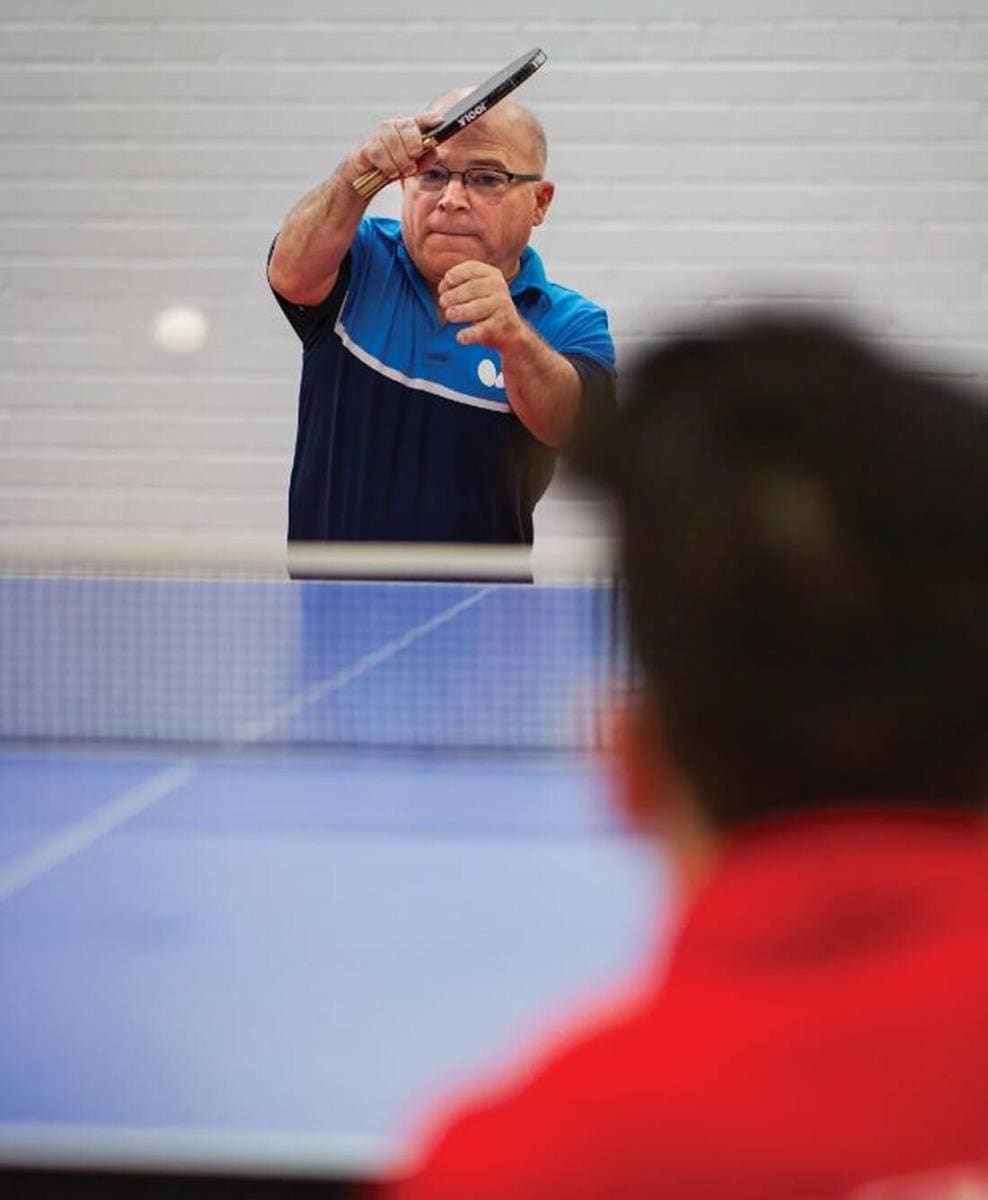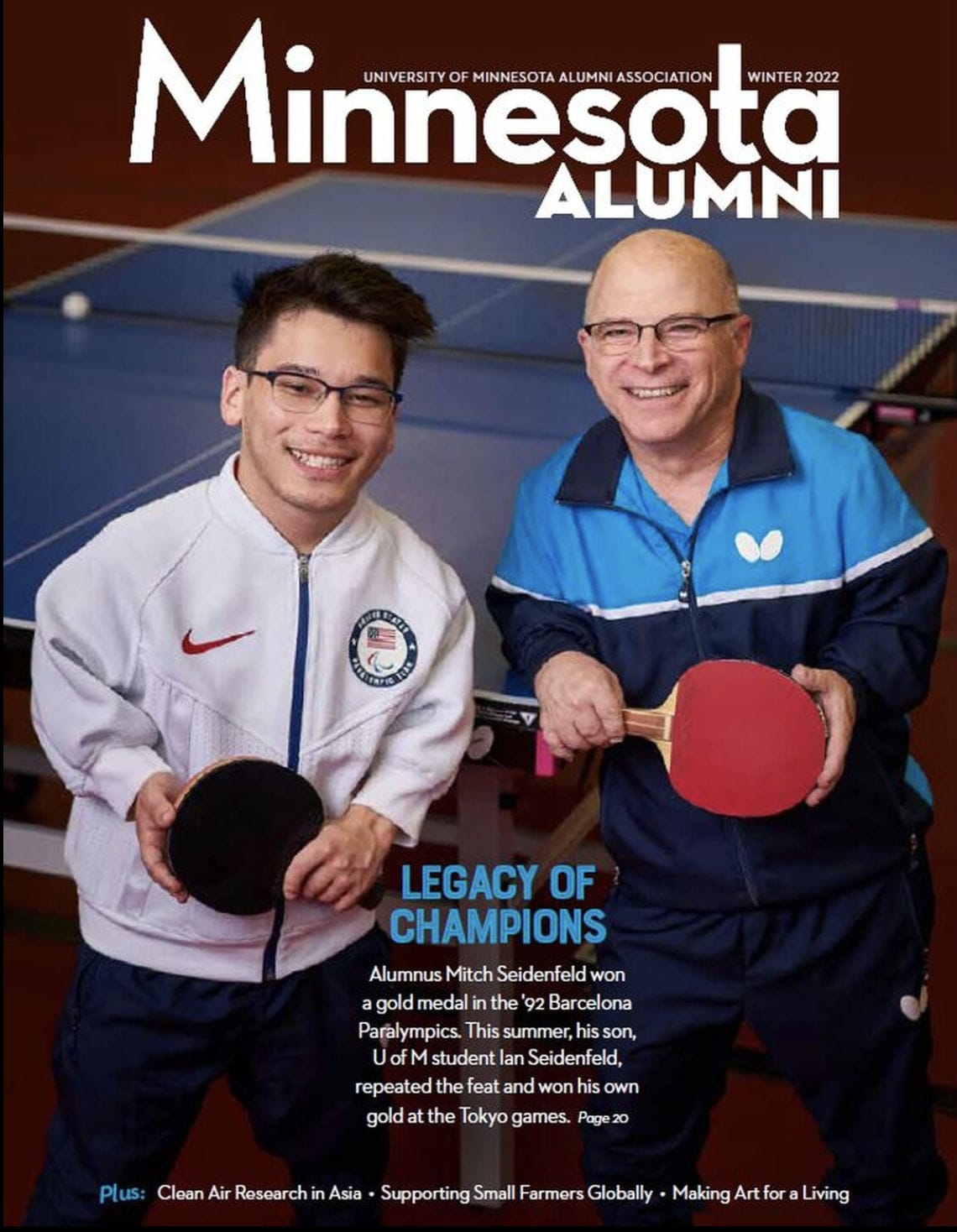Ian Seidenfeld is up 9-6 in the third game of the table tennis championship at the 2021 Paralympics in Tokyo when his opponent calls timeout. The University of Minnesota junior from Lakeville, Minnesota, is only two points from winning gold—something an American hasn’t accomplished in table tennis at the Paralympics since 1996—but the outcome of this match is far from decided.
The 20-year-old Seidenfeld, the youngest member of the USA table tennis national team, is playing in his first Paralympics, which kicked off in late August. His opponent, Peter Rosenmeier of Denmark, 37, is playing in his fifth and has already won two gold medals. Seidenfeld is seeded 11th in the Class 6 field, for those with impairments in their limbs. Rosenmeier is ranked No. 1 in the world. He’s beaten Seidenfeld once already at Tokyo in the preliminary round, the only match Seidenfeld has lost so far.

LINTAO ZHANG/GETTY
During the timeout, Ian retreats to his corner to talk to his father and coach, Mitchell “Mitch” Seidenfeld (B.A. ’92). Covid-19 travel restrictions have prevented his mother and older sister from traveling to Tokyo, but Mitch is there as the U.S. team coach.
Like his father, Ian has pseudoachondroplasia dwarfism, which inhibits bone growth. Often passed on genetically, the disorder is characterized by shorter limbs. Ian is 4 feet tall. His father, 4-foot-2. Mitch’s father and Ian’s late grandfather, Phil, also had the condition and was barely taller than his son and grandson at about 4-foot-6. Still, Phil captained his Iowa high school tennis team, was later the Des Moines city tennis champ, and became a teaching pro.
Phil Seidenfeld also taught his son Mitch to play both tennis and table tennis—at which he excelled.
Mitch would win his first international tournament in table tennis in 1990 while studying English at the U of M. Two years later, he would win a gold medal at the ‘92 Barcelona Paralympics. Over the next two decades, Mitch won another eight medals in international competitions and was inducted into the U.S. Table Tennis Hall of Fame. And as an award-winning coach, Mitch would teach his own son to play the family game at age 6.
By 8, Ian was playing tournaments. But for the first two years, he lost every match. Of course, his nose barely reached the table, and he was playing against kids who were taller. “It’s tough to win when you’re playing below the table,” Mitch points out.
Ian hated it. Not table tennis, but the losing. He played angry, wanting to destroy his opponent. The intensity became his superpower. He started winning. When he was a sophomore at Lakeville North High School, he won his first international tournament. More wins and solid finishes landed him a place on the U.S. national team and eventually led to this Paralympics match. Now, the pressure that began when he first started competing as the son of a table tennis great was peaking.
Asked later if he remembers what his father told him during that timeout, Ian smirks. “Not really.”
“He never really listens too precisely to me,” Mitch says.

Ian’s gold medal and, in theforeground, Mitchell’s “Order of Ikkos” medal, an award for excellence in coaching that was established prior to the 2008 Beijing Olympic Games. The award was inspired by Ikkos, the first recorded Olympic coach in ancient Greece. Recipients are chosen by U.S. Olympic or Paralympic medalists, each of whom may acknowledge one coach for their leadership in helping athletes achieve world-class success. Ian nominated the elder Seidenfeld for the honor.
MARK LUINENBURG
Back home after the games on a Friday afternoon in mid-September, they’re seated at the Table Tennis Minnesota training center in South St. Paul, with eight ping pong tables spread throughout a large, cavernous space. Ian’s wearing a maroon University of Minnesota T-shirt. Enrolled in the Carlson School of Management, he’s double majoring in finance and entrepreneurial management. Mitch, 58, wears a gray quarter-zip pullover that says “Team USA.”
Mitch completed the U of M English degree he started in 1981 just before winning his Paralympic gold medal in 1992. “Finishing the college requirements that I’d been putting off was quite an accomplishment for me,” he said afterward. “It gave me the confidence that I could do something really big in Barcelona.”
While both father and son are accomplished table tennis players, there are differences. Mitch is right-handed; Ian left. Mitchell is analytical, gregarious, a talker. Ian is more reserved, introverted, and occasionally sardonic. Their relationship as father and son can complicate their interactions as coach and player. “He sometimes feels when I’m coaching, I’m criticizing or fighting with him,” Mitch says. At which Ian smiles knowingly.
But during that critical Paralympics timeout, Mitch told Ian to stay focused and keep playing aggressively. There had been plenty of tense moments in the tournament leading to that point. Mitch had argued with the tournament referee over Ian’s use of an 18-inch wooden extension that slipped into the base of his paddle to return short serves he otherwise couldn’t reach—and prevailed using the argument there was nothing in the rules explicitly preventing it. “[Ian] knew I had his back,” Mitch says. “Throughout the tournament it had been the two of us against everyone else. This was the first time he trusted me to be on his team.”

Mitchell Seidenfeld trades shots with Ian at the Table Tennis Minnesota training center in South St. Paul.
MARK LUINENBURG
When play resumed after the timeout, Ian won the next rally to go up 10-6, only one point from fulfilling his longtime ambition. But then he dropped two quickly on Rosenmeier’s serve. (In their previous match Rosenmeier had also called a timeout, then went on a 7-2 run to turn the match around.) Ian’s face was set in a scowl.
Ian served; Rosenmeier returned the ball high. Ian smashed a winner.
11-8! The gold was his!
Ian had dreamt about this moment. Hoped for it. He had choreographed various celebrations. Rehearsed them in front of a mirror. But once it finally happened, all he could do was let out a gasp of excitement—while Mitch exclaimed, “Unbelievable!”—and rush into his father’s arms.
The two are not huggers. “We don’t do that,” Ian says later. But they lingered in a tight embrace, savoring the moment. When they finally parted, Ian’s face was frozen in a wide smile.
Afterward, the press asked Mitch which was more satisfying, winning his own gold medal in Barcelona or watching his son win one. “The two didn’t even compare,” he says. “Seeing him win was so much more satisfying. Nothing in sports can compare to watching my son win the gold medal.
“This whole experience has been a bonding of the generations,” Mitch says. “It has linked us.”
To which Ian smiles and nods.
